Gas bearing lubrication in turbomachinery
Gas bearing lubrication in Turbo equipment has been making slow but steady progress. Almost all fluid film lubrication applications in Turbo equipment use hydrodynamic(oil) or aerodynamic (gas) bearing technology. Hydrodynamic lubrication uses the relative shear between the bearing faces and the rotor to drag lubrication into the natural wedge-shaped gap that forms between them. We have seen the development of spray bar technology and leading-edge groove technology as methods of being sure there is oil at the leading edge of tilt pad bearings without having fully flooded bearing compartment. Aerodynamic gas bearings, such as foil bearings operate under the same principles as with the oil, but in seal applications therecannot be a leading edge as that would be a radial leak path. So,seal faces are 360 degree continuouswith shallow pumping groovesin one surface that also use relative motion to generate a bearing film that moves across the seal face from the high pressure to low pressure side.
This article will more fully detail the main types of gas bearings, their operating principles, how they were developed, and where they are used in Turbo equipment. With that introduction, we will look to what sort of practical improvements might be made to enable more applications of gas lubrication in Turbo equipment and what effects they may have on new equipment designs.
Dry Gas Seals (DGS)
Gas bearing lubrication got its start in Turbo equipment ironically, as a seal technology. For most of the 20th century,pipeline compressors had been built with oil-based seals. Nova, a Canadian pipeline company, had enough desire to move away from oil-based seals to try aerodynamic gas bearing technology as a compressor seal back in the early 60s and working in conjunction with them, John Crane received a patent for the first dry gas seal, using aerodynamic bearing principles in 1963.
Dry gas seals are face seals that use fine laser or chemical etching to create shallow pumping grooves about 0.0003 inches deep in one of the seal faces. When spinning, these grooves pump gas into the gap from the high-pressure side to increase the pressure of the gas between the faces. These grooves are modified depending on the application for the seal, for instance some grooves may provide for rotation in both directions and another design might be optimized for rotation in one direction (Figure 1).
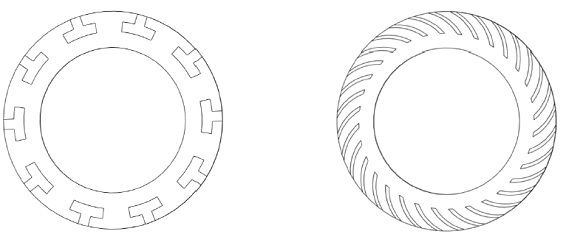
Figure 1[/caption]
Dry gas seals are also balanced, meaning that the pressure being sealed comes behind the stationary seal face to a balance point (Figure 2). This balance point will expose process pressure to some percentage of the back of the seal depending on the requirements for the application’s closing force. This means the pressure being sealed is squeezing the two seal faces together. This pressure is also trying to get between the two seal faces and push them apart. Obviously if the pressure can push the seal faces wide apart, it would not be a seal. So, seal designers always want a higher closing force to maintain seal functionality, but not so high a force as to create heat or wear on the dynamic surfaces. This closing force is typically a function of the balance point and the springs selected.
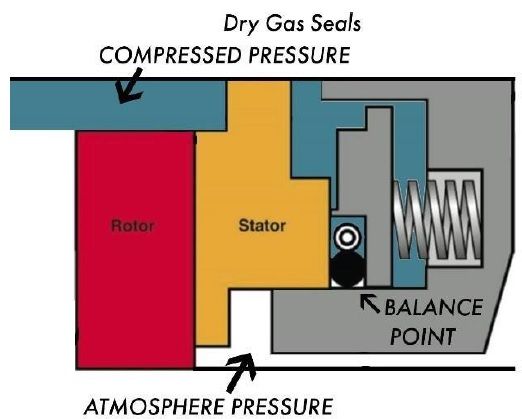
Figure 2[/caption]
The genius of using process pressure to balance most of the change in forces is that it is self-regulating. The pumping grooves cover the load capacity of the extra closing force required from the springs.
This is a relatively narrow margin and dependent on conditions like speed and cleanliness, but dry gas seals have virtually replaced all oil seals in new compressor builds.
It is interesting to look to the gas lubrication conditions in DGSs; if there is 2000psi being contained by the seal, then there will be 2000psi of unit loading in the fluid film, as that is the pressure squeezing the faces together. The pumping grooves in the seal faces create enough of a pressure margin to keep a gap between stationary and rotating faces. This gap might be quite thin because the pressure difference from the pumping grooves will not be very high. Shear losses in fluid film lubrication are a cubed function of the gap so very small gaps can generate a lot of shear heat, even in gases. DGS seal faces are often made from very rigid and thermally stable silicon carbide. The idea is to have stiff and thermally stable surfaces to keep the faces flat even under the high pressures or thermal gradients they see from shear in operation. If the gas gap is only 0.00015 inches, the relative flatness of the surfaces needs to start off and stay, less than the gas gap. Still with these caveats, amazingly 2000psi is higher unit loading then can be achieved with hydrodynamic oil bearings! Where DGS have been applied, they have eliminated issues with process contaminated seal oil and improved efficiency with orders of magnitude less friction. DGSs are a dramatic improvement over oil seals and an impressive example of gas bearing lubrication.
Foil Bearings
Foil bearings are another type of gas bearing that employs aerodynamic lubrication principles. They have a long history of operation in military and commercial aircraft as compressor bearings in Air Cycle Machines (ACMs) used to manage cooling, heating and pressurization of the aircraft. The first production ACM using foil gas bearings was designed and developed for the DC-10 in 1969 by Garrett AIResearch. Shortly after, other companies like Hamilton Standard and Sundstrand were also developing foil gas bearing technology and today virtually every medium to large aircraft flying uses this technology.
Foil gas bearings have shown excellent long-term reliability in ACMs. Many such gas foil compressor bearings have demonstrated operation on working fluids other than air, such as hydrogen, refrigerants, liquid oxygen or supercritical CO2 as examples. The ability to operate at cryogenic or very high temperatures is another advantage of the technology. Gases take the heat and cold better than oil, as gases typically do not change their viscosity much relative to temperature, this helps keep the rotordynamics simple. Today, foil bearings are also commonly used in blowers for water treatment processes, sub megawatt gas turbines and turbo chargers. The ability of foil bearings to reduce friction and eliminate the contamination and weight issues of oil systems has been a key to their success.
There are many types of foil bearings, most common are the Bump and Overleaf types. The Bump Foil Bearing (BFB) consists basically of a thin flat piece of spring steel that is stamped to have waves that constitute the bumps, it is rolled and inserted into a precision bore. A thin top foil, often with a low friction coating is inserted into the ID and is supported by the bumps (Figure 3).
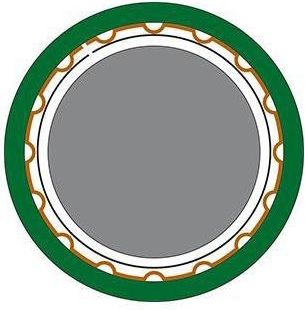
Figure 3[/caption]
Generally, only a few thousandths of an inch of radial clearance is designed between the top foil face and the OD of the rotor, since clearances can be a challenge working with stampings and foils, the idea is that the bumps are compliant and as the load goes up, more bumps come in to play, distributing the load across a broad area. The rotor could still whirl or whip inside of the design clearance, so it is not unusual to see BFBs shimmed between the precision bore and the bump strip to reduce the clearance in three or four spots.
The Overleafis an alternative foil design, rather than using a continuous top foil, separate but stiffer leaves overlap but have longer bending moments, this provides relatively low stiffness over a larger range (Figure 4). This helps to provide the classic wedge-shaped gas gap and reduce whirl and whip instabilities, but the bending of the leaves produces even less damping than the friction losses in the BFB. It is though, relatively easy to get some preload, that is a bearing inner ID smaller than the shaft OD without shim. It is also common to see the Overleaf design in thrust bearing applications.
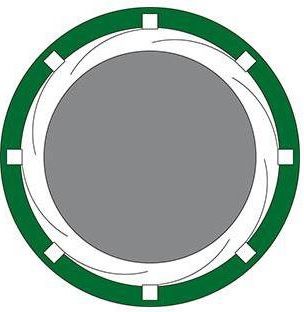
Figure 4[/caption]
A third type of foil bearing, Metal Meshfoil bearings have been attracting a lot of interest and research in recent years (Figure 5). The idea is like the BFB in that there is a continuous top foil, but it is supported by a metal wire mesh, sort of like a sponge rather than bumps. The mesh may be of stainless steel, aluminum or copper. The friction losses between the wires in the mesh as they “spring” is said to result in a damping mechanism that is insensitive even to the high heat levels in gas turbines.
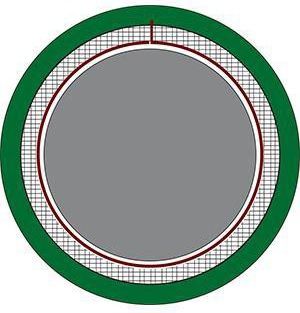
Figure 5[/caption]
Aerostatic Lubrication
Aerostatic lubrication is the most common type of gas bearing outside of the turbo industries. Aerostatic gas or air bearings are commonly used in the machine tool, metrology, semiconductor, and medical industries to name a few. There are no machine tool spindles that use foil bearings. The low stiffness and low precision make them inappropriate. There are tens of thousands of high-speed spindles using aerostatic air bearings. Applications include circuit board drilling, high speed milling, precision grinding, even dental drills use aerostatic bearings rather than aerodynamic bearings.
Metrology machines have long used aerostatic bearings. Almost all coordinate measuring machines (CMMs) use aerostatic bearings. Typically, the controller and software of the CMMbecome out dated long before the air bearings wear out. If you have a CMM in your shop, ask the operator if they are aware of ever changing the bearings or had an issue with them, the answer is likely no. Then look for the small box on the side of the base that contains the filterdryer for the air supply. Ask when the filter was last changed. The answer is often never, even though the machine may be decades old. Then look for the clean tracks the bearingsmake as they push the chips and dust out of their way on the granite guideway.
Hard disk drives and read heads in the early days of the computer industry were all made with aerostatic air bearing spindles. Today, lithography machines using aerostatic bearings print 18 nanometer wide lines on top of each other within a few nanometers and they do it at a speed in excess of one meter per second. Remember, there are 1000 nanometers in a micron. Aerostatic bearings have demonstrated in industrial applications they are precise, robust, and economical, but have seldom been applied in turbo applications.
What is Compensation?
Aerostatic bearings are also called Externally Pressurized gas bearings and can provide lift even at zero RPM. Although they do not have fine pumping grooves like dynamic bearings, they do require some type of restriction for metering the gas into the gap. Air pressure is introduced directly between the bearing surfaces though precision holes, orifices, grooves, steps or porous compensation techniques. It is this process of restriction referred to as compensation that is key but not yet well appreciated in the turbo industries.
Compensation enables bearing faces to run very close together without touching, because the closer they get together, the higher the gas pressure between them gets, repelling the faces apart. Under an aerostatic gas bearing the average pressure in the gap will equal the total load on the bearing divided by the face area. That is the unit loading. So, if the source gas pressure is 100psi and the seal face has 10sq.in. of area and there is 600lbs. of load, there will be an average of 60psi in the bearing gap. Because there is a restrictor of some type just before the gap, if the load increases to 700lbs, the bearing gap reduces, choking flow in the gap and so the restrictor has less differential and can let the average pressure in the gap increase to 70psi. Without a restriction at each bearing face, all of the air supplypressure would flow out of the bearing with the lowest load and no other bearing would have lift. Also, the more restriction or compensation, the lower the initial lift will be and so the stiffness will be higher as their will be less change in gap for a given change in load.
Orifice Compensation
Out of all the compensation techniques, orifice compensation is the most popular and widely used. This is also the technology Don Bently employed when he started the Bently Pressurized Bearing Co. Yes, after selling Bently Nevada to GE, Don thought he could solve many of the problems he had identified with his eddy current probes by employing aerostatic bearings, but that is another story (See Sidebar). Orifice compensation typically uses precisely sized orifices that are strategically placed on the bearing face and often combined with shallow grooves to distribute the pressurized air across the bearing face. However, if the bearing face becomes scratched across a groove or near an orifice, the volume of air that escapes through the scratch may well be more than the orifice can supply, causing the bearing faces to contact or crash. Orifice bearings also can be plagued by contamination plugging the orifice and starving the face for pressure and flow. Orifices are typically 0.004 to 0.010 in. (100 to 250 μm) in diameter and so can be readily plugged by Teflon tape or material sloughing off the inside of the tube or some other particulate contamination. Finally, orifice bearings experience collapse at very small gaps. As the face of the bearing gets closer to the guide surface, the inflow around the feed hole becomes choked and is not enough to provide pressure and flow for the rest of the face.
Porous Compensation
The ideal gas bearing design would supply pressure equally across the whole face of the bearing and automatically restrict and dampen the flow of air to the face at the same time. This can be achieved by diffusing air through a porous bearing or seal face, graphite and carbons are naturally porous and may be used for this purpose. The stability of porous compensation is due to the damping effect from the torturous passageways the gas must flow through to reach the face. This damping effect makes it difficult for the volume of air in the gap to change quickly, resulting in a naturally stable gas film that cannot be plugged by particulates. As even with the supply tubes and/or ports completely full of particulates (sand, dust, etc.), it still does not create as much restriction as the porous media itself. In the case there is contact, graphite and carbon are good plain bearing materials that are well known in the industry.
Externally Pressurized Porous (EPP) compensation also works well for very small gaps and so small flows, as porous bearings do not experience collapse. With a porous bearing having 10sq.in. of area and 100psi supply pressure, the bearing will be in “balanced force mode” with 1000lbs. of load. That is an interesting lubrication regime where there is zero lift and so zero flow but zero load and friction between the faces, as the load is taken by the air pressure acting like a hydraulic cylinder. This contact mode does not pertain to the fluid film bearings under discussion but is another example of why porous compensation has better crash resistance and is more robust than orifice compensation. But this contact mode is interesting for mechanical seal faces, brushes, exciters, and commutators that are often made of graphite or carbon and do run in contact1.
Rotor Dynamic Considerations
The accompanying charthelps to conceptualize gas bearing lubrication technology in turbo equipment (Chart 1). It is a lift vs load chart for the Externally Pressurized Porous (EPP) gas bearing described above that has 10sq.in. of bearing face, 100psi is fed to the bearing as the load on the bearing is increased. Resulting air gaps are shown on the bottom axis. The slope of the curve around any load point is representative of the film stiffness at that load. This curve is similar to curves seen for DGS or eccentricity plots used in rotor dynamics. The typical operating regions of DGS and foil bearings are superimposed as is the operating area for EPP Bearings.

Chart 1[/caption]
It can be seen that the EPP Bearings operate with a larger gap than dry gas seals, reducing heating and contact issues but still having good load capacity, stiffness, damping and speed capabilities. Possibly the biggest advantage is that external pressurization gives an equipment operator a new knob to turn, being able to adjust the bearing or seal from outside the machine. If the seal or bearing is running hot, turning up the source pressure will increase the gap proportionally with the increasing pressure, but there is leverage, as shear in the gap will fall on a cubed function of the increasing gap.
This adjustability is also an advantage regarding rotor dynamic issues. The destabilizing effects of cross-coupled stiffness are caused by the parasitic shear losses in the fluid film as the rotor gets traction to climb up the side of the journal.Don Bently clearly pointed out that when the viscosity of the fluid film is reduced by two orders of magnitude, cross-coupled instabilities are eliminated as the rotor gets no traction at the same relative surface speeds. This is important for increasing the machines efficiency but also allows for dramatically increasing surface speeds. At some point the increasing speed will start to cause significant shear again but remember that the bearing properties of externally pressurized bearings may be modified while in operation by adjusting the pressure supply regulator as noted above.
It should be noted that it is not desirable to increase the input pressure more than necessary, a larger gap than needed reduces stiffness and damping, just as seen in rotor eccentricity plots. So consistent with eccentricity plots, although it may be counterintuitive, turning the air pressure supply down will increase the stiffness and damping as the gap is reduced. Dr. San Andres of the Texas A&M Turbo Lab has been studying EPP gas bearings and noted “Gas bearings with external pressure permit operation with minute clearances and offer high stiffness for accurate positioning while operating with little shear drag and provide enhanced stability due to the absence of cross-coupled stiffnesses induced by hydrodynamic effects.”3
It is commonly thought air or gas bearings have little damping. This because most applications have used gas films of .001 inches or more. At this point on the curve, there is near zero stiffness. At zero stiffness there can be no damping, it is like hanging the rotor on surgical tubing to ring it and find its undamped natural frequency. As supply pressure is reduced, stiffness increases, providing resistance to motion and so providing damping. As some point the stiffness can become too high, if there is zero motion there can also be no damping. The ability to adjust bearing parameters in externally pressurized bearings with something as simple as a pressure regulator is a big advantage over oil or foil dynamic bearings that are not adjustable and alsomagnetic bearings there are more complicated to adjust.
There is still another important advantage to the damping associated with gas bearings. As noted above, stiffness can be too high. A squeeze film oil damper may provide high damping at 3600rpm but at 10,000rpm provide no damping as it locks up, becoming infinitely stiff relative to the higher frequency vibrations. Because of the low viscosity of air and gasses, gas bearings are appropriate for damping high frequency vibrations. This is consistent with the higher speed capabilities of gas bearingsand the trend toward smaller higher speed turbo equipment.
The Future
The future of Turbo equipment looks smaller and faster. Microturbines, from companies like Capstone, are making progress in distributed energy. Capstone uses foil bearings of their own design.
Waste heat recovery from simple cycle gas turbines and other heat engines is attracting more attention. Super Critical CO2 (sCO2) power cycles are a leading technology for this because of their very high-power density. This minimizes the size of the equipment to the point that a 100mmimpeller can do 1MW worth of work. This order of magnitude reduction of equipment mass is critical to making waste heat recovery practical and economical.
In such high-power density applications, the impeller tip to stator clearance becomes critically important in machine efficiency because flow through a gap is a cubed function of the gap.
So how do we reduce impeller clearances? One place to start is to look at the thermal growth of the rotor between the thrust bearing and the impeller. Often the rotor reaches through an oil bearing or labyrinth seal making for large displacements.
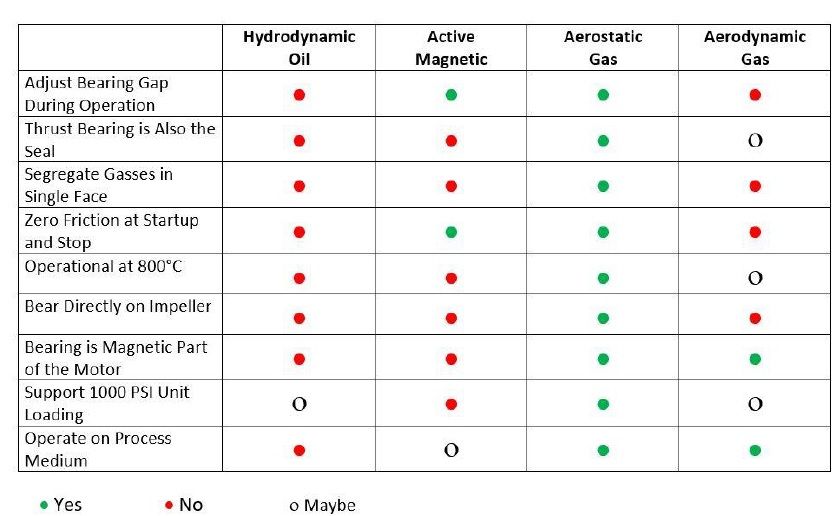
Chart 2
Using low coefficient of thermal expansion (CTE) materials is another way to reduce thermal growth. Composite matrix ceramics (CMCs) and carbon, carbon materials developed for rocket nozzles and power turbine blades are now being used for aircraft and Formula 1 racecar brake discs and pads. CMCs are naturally porous, but they can also be sealed. If CMCs are used to make bearings, rotors, and housings they would enable higher modulus, even at 1000°C, less corrosion, lighter weight, lower CTE, and better thermal insulation for compact turbines and compressors.
If we are to be flying around in self-driving drones, improved gas turbines are the likely motive power. If the distributed power model is applied to hybrid electric cars, each car will have a turbine and so will not need charging stations. If the gas turbine industry is going to power the future, it will need to let go of past design constraints. Considering precision engineering principles including gas bearings and new materials in the context of a clean design state will help enable more powerful and compact turbine design.